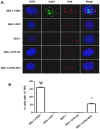Effects of TIN2 on telomeres and chromosomes in the human gastric epithelial cell line GES-1
- PMID: 29552152
- PMCID: PMC5840751
- DOI: 10.3892/ol.2018.7927
Effects of TIN2 on telomeres and chromosomes in the human gastric epithelial cell line GES-1
Abstract
TERF1-interacting nuclear factor 2 (TIN2) is a key member of the protein complexes that protect telomeres. TIN2 contributes an important role in biological processes. In a previous study by the present authors, an association was reported between high TIN2 protein expression and gastric cancer. Therefore, it was hypothesized that abnormal TIN2 expression may cause the development of malignancies, including, gastric carcinomas. To investigate this hypothesis, the present study employed peptide nucleic acid fluorescence in situ hybridization technology to analyze the human gastric epithelial GES-1 cells with high TIN2 expression or inhibited TIN2 expression. The results indicated that GES-1 cell lines with high TIN2 expression exhibited greater telomere dysfunction-induced damage compared with GES-1 cell lines with inhibited TIN2 expression. Chromosome analysis indicated that GES-1 cells with high TIN2 expression exhibited 2.48±1.30 aberrant chromosomal changes per 100 cells, that may contribute to telomere DNA damage. Therefore, aberrant chromosomal alterations may provide a novel perspective for the pathogenesis of gastric cancer.
Keywords: GES-1 cells; TERF1-interacting nuclear factor 2; chromosome aberration; telomere dysfunction induced-foci.
Figures




Similar articles
-
Higher-order nuclear organization in growth arrest of human mammary epithelial cells: a novel role for telomere-associated protein TIN2.J Cell Sci. 2005 Mar 15;118(Pt 6):1321-30. doi: 10.1242/jcs.01709. Epub 2005 Mar 1. J Cell Sci. 2005. PMID: 15741234 Free PMC article.
-
Expression of telomeric repeat binding factor 1 and 2 and TRF1-interacting nuclear protein 2 in human gastric carcinomas.Int J Oncol. 2001 Sep;19(3):507-12. Int J Oncol. 2001. PMID: 11494028
-
TIN2 is a tankyrase 1 PARP modulator in the TRF1 telomere length control complex.Nat Genet. 2004 Jun;36(6):618-23. doi: 10.1038/ng1360. Epub 2004 May 9. Nat Genet. 2004. PMID: 15133513
-
Mus musculus and Mus spretus homologues of the human telomere-associated protein TIN2.Genomics. 2003 Apr;81(4):422-32. doi: 10.1016/s0888-7543(02)00033-2. Genomics. 2003. PMID: 12676566
-
Telomeres and chromosome instability.DNA Repair (Amst). 2006 Sep 8;5(9-10):1082-92. doi: 10.1016/j.dnarep.2006.05.030. Epub 2006 Jun 19. DNA Repair (Amst). 2006. PMID: 16784900 Review.
Cited by
-
Dextran sulfate inhibition on human gastric cancer cells invasion, migration and epithelial-mesenchymal transformation.Oncol Lett. 2018 Oct;16(4):5041-5049. doi: 10.3892/ol.2018.9251. Epub 2018 Aug 2. Oncol Lett. 2018. PMID: 30250571 Free PMC article.
-
Telomeres and Mitochondrial Metabolism: Implications for Cellular Senescence and Age-related Diseases.Stem Cell Rev Rep. 2022 Oct;18(7):2315-2327. doi: 10.1007/s12015-022-10370-8. Epub 2022 Apr 23. Stem Cell Rev Rep. 2022. PMID: 35460064 Free PMC article. Review.
-
Identifying potential novel insights for COVID-19 pathogenesis and therapeutics using an integrated bioinformatics analysis of host transcriptome.Int J Biol Macromol. 2022 Jan 1;194:770-780. doi: 10.1016/j.ijbiomac.2021.11.124. Epub 2021 Nov 24. Int J Biol Macromol. 2022. PMID: 34826456 Free PMC article.
References
LinkOut - more resources
Full Text Sources
Other Literature Sources
